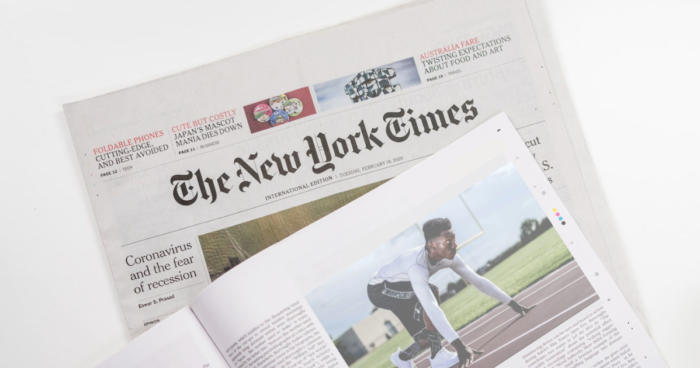
The New York Times shuts down its sports desk
The New York Times shuts down its sports desk: questions about the future of sports journalism
By Dr. Rosarita Cuccoli, professor of sport sociology at the University of Verona and member of the Scientific Committee of Sport and Citizenship advising on the news media.
31/07/2023

The New York Times (NYT) will no longer have a freestanding Sports desk. The public announcement was made on July 10, 2023 via a note on the company’s website from publisher A.G. Sulzberger and CEO Meredith Kopit Levien, meaningfully titled “Our Plans for Sports Journalism”.[1] The daily sports coverage of games, players and leagues will now come primarily from The Athletic, a subscription-based online sports news outlet, which the NYT acquired in January 2022 for $550 million. In an e-mail to the NYT staff, also on July 10, NYT executive editor Joe Kahn and deputy managing editor Monica Drake explained the shift: “We plan to focus even more directly on distinctive, high-impact news and enterprise journalism about how sports intersect with money, power, culture, politics and society at large (…) We will scale back the newsroom’s coverage of games, players, teams and leagues”.[2]
The Athletic was created in 2016 by Alex Mather and Adam Hansmann and has a staff of around 400 people. Sports stories for the Times’s website will be sourced from the nearly 150 daily stories published by The Athletic, Sulzberger and Levien said. Articles from The Athletic will also appear in the print NYT. The 35 members of the NYT’s Sports desk will not lose their job, the company said. They will be reassigned to other departments, and some of them will actually be able to continue “to produce the signature general interest journalism about sports — exploring the business, culture and power structures of sports, particularly through enterprising reporting and investigations — for which they are so well known”, Sulzberger and Levien added.
So, The Athletic has de facto become the sports department of the NYT, but having said that, questions remain about how they will complement each other in practical terms. For example, The Athletic operates under separate reporting standards and codes of ethics. Furthermore, unlike many of those who work at the Times’s newsroom, the journalists at The Athletic are not unionized. The New York Times Guild, that is the union representing the NYT’s newsroom, posted the following tweet from its Twitter account on July 10: “We will fight this flagrant attempt at union-busting with every tool we have. And we will work with our members in Sports to defend their rights under our union contract.” The union also sent a formal labour grievance to the NYT’s executives on July 20, accusing the company of violating the union contract by “unilaterally removing bargaining unit work and by assigning such work to non-bargaining unit employees”, the Washington Post has reported.[3]
In this brief editorial, we shall let aside labour issues, which are unquestionably important if only on the grounds that this evolution could set a precedent involving other desks at the newspaper. Incidentally, these issues are not yet sorted out at the time of writing of this article. We shall rather focus here on the implications in terms of contents, which matter to journalism, although they are inevitably connected with the business side of the story. In today’s communication landscape, the great availability of sources that present the daily news about games and athletes pushes the so-called “traditional” media outlets to propose, in terms of content, an alternative journalistic offer. Skilled and experienced sports journalists like the ones at the NYT are undoubtedly among the best placed in the world to explore “the business, culture and power structures of sports” NYT leadership referred to. It seems perfectly reasonable that the daily sports news of games and athletes should be covered by an online outlet of the same news group that already does the job – assuming that contractual and other transition issues are fixed. One may legitimately wonder, however, whether a rational adjustment to the rapidly evolving media landscape was inevitably to lead to the killing of the Sports desk of the most respected newspaper in the world. As reporters from the NYT itself reminded when announcing the disbanding of the sports desk, its coverage of games and athletes was once “a pillar of American sports journalism”.[4] Will this empower or ultimately weaken sports journalism?
Photo : @Pexels, edit by Sport and Citizenship
[1] “Our Plans for Sports Journalism.” The New York Times, July 10, 2023. https://www.nytco.com/press/our-plans-for-sports-journalism/
[2] Quoted by Katie Robertson and John Koblin in “The New York Times to Disband Its Sports Department.” The New York Times, July 10, 2023. https://www.nytimes.com/2023/07/10/business/media/the-new-york-times-sports-department.html
[3] Strauss, Ben. “New York Times files grievance over plan to close sports desk.” The Washington Post, July 20, 2023. https://www.washingtonpost.com/sports/2023/07/20/new-york-times-sports-union-athletic/
[4] Robertson and Koblin in The New York Times, July 10, 2023.
